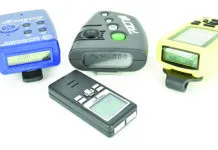Some parts of the country, notably California, dont permit their fine, law-abiding citizens to own so-called “black rifles,” which generally means you cant have an AR-15 if you live there. But you may still want a rifle that handles the .223 cartridge, for a number of reasons. One may be to take advantage of the low-priced “deals” that often come along on surplus .223 or 5.56 ammunition.
The need for a non-semiauto .223 is generally met by a bolt-action rifle. Many companies have made delightful little rifles for the .223 over the years, notably Sako and various suppliers of the so-called Mini Mauser in that caliber. The Sako Vixen is still much sought-after, though prices continue to climb, with new versions (Sako 85) around $1600 today.
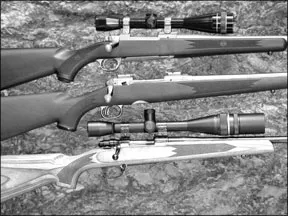
There are plenty of other more affordable choices, however, and for this test we chose three rifles in the $550 to $750 range. The guns were Savages Model 16FSS “Weather Warrior” in stainless/synthetic ($569), Rugers new Hawkeye “All-Weather” also in stainless/synthetic ($749), and Remingtons Zastava-made Model 799 in blue/laminated ($648).
We tested the three with two factory loads by Black Hills, a 62-grain FMJ and a 60-grain JSP, as well as Remingtons 55-grain PSP. We also tried two low-cost surplus brands of FMJ ammunition that were loaded in Russia, typical of so much of the very inexpensive stuff that will inevitably find its way into almost all .223 rifles. One of these was brand-named Wolf, and the other was white-box Russian. We also experimented with very-heavy-bullet handloads designed for 1:7-inch twist, but results were uniformly so poor we didnt record them. Here is what we found.
Savage Model 16FSS
No. 17420, $569
Our Savage was a handy, well-balanced rifle that tipped the scales without scope at 6.7 pounds. The black stock had a blind magazine (five rounds), so the lines of the rifle were slim and trim – although Savages new flush, hinged floorplate is just as neat, though not available on this model. The Model 16s stainless barrel was free-floated back to the slick stainless action. And we do mean slick. The bolt ran back and forth like it was on ball bearings, a feature common to most Savages weve handled. The Ruger had about the same quality of smoothness, but the Remington wasnt in the same class at all.
The Savage had many features we liked. Notable were the wonderful AccuTrigger, the nicely finished stainless barrel, the stainless action with that slick bolt, and the already-mounted scope bases. The plastic stock had excellent checkering – better than Rugers – and a thick, soft recoil pad that didnt quite match the clean lines of the stock. The Savage was full size, and with our 30X Leupold scope attached – using the Weaver-type bases
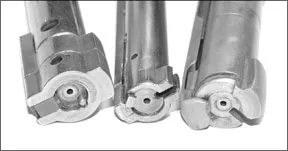
provided by Savage – we found the balance to be excellent. We particularly liked the clean machining on the action surfaces. There were no sharp edges, and the metalwork was exceptionally well done and tasteful, we thought. The 22-inch, button-rifled barrel tapered to 0.585 inch at the muzzle, about the same as on the Ruger and Remington.
The magazine had a plastic follower. The near-silent three-position tang safety let us cycle the rounds out of the magazine safely and easily when we wanted to unload the rifle. The deeply recessed head of the bolt held a plunger ejector and sliding extractor, and both worked perfectly. We mounted our Leupold 30X target scope and headed for the range. A few shots with decent ammo told us we once again had a winner in this Savage. Both the Ruger and Savage showed a distinct preference for Black Hills 60- grain JSP, but Savage clearly won the day. This rifle consistently put three of them into groups smaller than an inch. The best was 0.6 inch. In fact we fired no groups with that ammunition through the Savage that were over an inch. The Russian surplus fodder proved again that a rifle is no better than its ammo. Groups averaged about 3.5 inches. Bargain-basement shooting isnt the best way to get outstanding results, and all three rifles here indicated that. Going back to decent ammunition, the Remington 55-grain PSP averaged 1.2 inches.
Ruger Hawkeye All-Weather
HKM77RFP, $749
This Hawkeye utilized a shorter action than the .338 Hawkeye tested recently, but in many respects is a similar rifle. The recoil
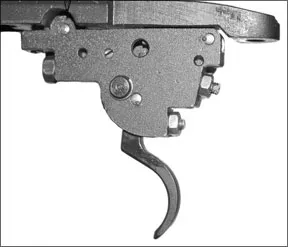
pad is once again the wonderful new soft black one, which worked so well to tame the .338. Unneeded on the .223, it still was a comfort, and it also kept the rifle from skidding on slick floors. This version of the Hawkeye had excellent handling characteristics, excellent looks, and mighty good checkering, though it didnt grip our hands as well as that on the Savage. The Hawkeye action again had a full-length “controlled feed” extractor. The bolt operation was very slick from the start, and got slicker as we tested it. The bolt had a lump like that found on the famous Winchester Model 70 which helped reduce drag and binding.
The controls and setup were all standard Ruger. The magazine held five rounds, and there was a button in the trigger guard to empty the magazine through the hinged floorplate. We noted the trigger was again on the heavy side for weight at 4.6 pounds, but it was extremely crisp, with zero creep. We predict this new Ruger trigger will soon be looked upon as one of the best in the industry. We still believe the best trigger is Savages AccuTrigger, which we doubt can be beat short of someone coming up with a similar design. It would be great, we thought, if Ruger could incorporate an adjustment on the pull strength. It looks like this would be easy to do, short of any potential legal aspects.
Inletting was superlative here, the best of all three rifles. The 22-inch barrel was fully bedded, and all the metalwork was finished in Rugers dead gray color we like so much. We noted this shorter action didnt have the large-radius curve between the rail and the front action ring that we saw on the .338 Hawkeye.
Mounting our test scope was easy, thanks to the rings that come with all Ruger rifles. These are uniform within the Ruger family. If you have a scope mounted on, say, your .338 Hawkeye you can pull it off and use the same rings to mount that scope on your .223. Youll have to move one ring, because the .223 uses a shorter action.
On the range we found this Hawkeye magazine not the easiest to load. The rear lip of the box is uncovered when the bolt is fully rearward. We had to position the rounds slightly toward the muzzle before pressing them downward, or they wouldnt go in. Once the knack is learned, its easy. Feeding was impressively consistent and positive for all rounds in the magazine, even with a sixth round in the chamber. Ejection was equally positive, and of course dependent on the bolt speed.
Accuracy was again largely dependent on ammunition quality. The Wolf and other Russian surplus fodder, which is often sold for
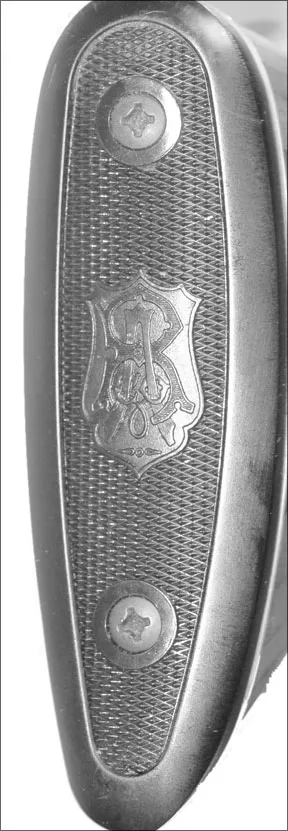
close to give-away prices, didnt get anywhere near the maximum the Ruger had to offer. Again the 60-grain Black Hills JSP was the winner, groups averaging 1.2 inches. The Ruger didnt much like the Remington PSP. Although we felt a lighter trigger would have helped, we didnt believe the use of the 30X scope would have resulted in smaller groups. In the recent past our test shooters have printed many sub-MOA groups with scopes of only 2.5X, from the machine rest.
Remington Model 799
No. 89850, $648
The Remington Model 799 is made by Zastava in Serbia. Its a close copy of the Mauser 98, although reduced in size in all directions, and with a few substitutions. Other makers have produced similar rifles in the past. They went by various names, notably Mini Mauser. The Remington 799 does not have the Mauser full-length claw-type extractor, despite what it says on the Remington website (www.remington.com). It has a smaller, spring-loaded piece that extends over the recessed face of the bolt to grab the cartridge. There is a guide bar on the side of the bolt that looks a lot like that on a Sako rifle. The bluing was excellent, with decent polishing.
The bare rifle weighed 6.75 pounds. While thats on par with the other two, it seemed this nice little action was lost in a mass of unneeded wood. The bolt and action were much smaller than those of the other two rifles in this test. The 799 could have – should have – weighed lots less than it did, we thought. The culprit was the laminated stock, which weighed 2.65 pounds. With our scope mounted, the 799 weighed 8 pounds. Our test scope weighs 1.2 pounds, so the barreled action, minus scope and stock, weighed only 4.1 pounds. We thought the 799 could weigh around 5.5 pounds with a proper stock and no scope. In that guise it would have had a lot more charm, we thought. Why bury a tiny, lightweight action inside a heavy rifle? We found a tiny dab of glass bedding near the front of the action within the stock. The adult-size laminated stock was attractive enough. The inletting left a bit to be desired, we thought. The stock finish was excellent, and so was the checkering. The hard butt plate carried the classy old Remington Arms logo, surrounded by checkering.
The action was all steel, including the magazine follower. We could find no aluminum nor plastic parts on this attractive little action. The polishing and bluing were excellent. The 20-inch barrel was free floated. The action was retained with two Allen screws. We liked the magazine floor-plate release, which was a transverse button at the front of the trigger guard. Shotgunners used to a safety at the front of the trigger guard will have to remember where the real safety is, to avoid dumping the contents of the magazine before every shot.
Unfortunately, the bolt was rough in all its operations. It took significant force to open or close it, and even more to move it back and forth. It dragged, and didnt want to move fully rearward easily. Oil didnt help. This gritty feeling seemed to decrease when we mounted the scope, but then we realized the bolt had sufficient sideways play that its lever was rubbing on the scope, limiting the sideways play and thus reducing the drag. This was not a good setup. The trigger pull also was horrible. It broke at just under 5 pounds, but just before that there were two or three stages of sticky creep. The trigger was fully adjustable, though the adjustments were “locked” with paint. We left it alone.
Notoriously missing were any sort of scope bases. Remington told us that Warne, Weaver, and a few other outfits make suitable bases, and any that are marked for either the Interarms Mini Mark X, the Mini Mauser, or the Remington 799 will work. Our fine friends at Brownells (www.brownells.com, [800] 741-0015) went out of their way to quickly get us a set of Weaver bases (numbers 71A and 23) and some suitable rings by Burris, though in the interests of saving time we used our standard Weaver rings. We cant understand why some simple, low-cost bases are not supplied with the rifle. Savage does this, and gives other scope-base information on its website so you dont have to fumble trying to get the right bases. The savings in aggravation are immense. The cost for these bases could not be more than a few pennies per set when ordered in quantity. If we had a hard time obtaining them, we suspect most buyers of this rifle will also.
Close inspection failed to show us any reason for the sticky-bolt problem other than the loose bolt fit. We found a sharp edge on the lower edge of the bolts guide rail that didnt help things. On the range we ran into feeding problems. The rifle gave us several failures to feed when the upcoming round popped out of the magazine as the spent case was ejected. We also had some failures to feed even when the rounds stayed put properly. The nose of the incoming cartridge occasionally rose too high to enter the chamber. Ejection proved to be quite good, however, and there were no failures to fire.
The Remington website (www.remington.com) gave the twist rate of the Zastava/Remington at 1 turn in 12 inches. That would seem to favor lighter bullets. Our targets verified this when the 60-grain Black Hills ammunition gave only 1.5-inch groups. In the other two rifles that ammo gave the best results. In desperation we tried a few rounds of a handload using the 40-grain Barnes Varminator bullet. Sure enough, that gave the smallest groups from the Remington, an inch on average. We also got good accuracy with Remingtons own ammo. Both the other rifles had 1:9 twist rates, and had better results with heavier bullets.






















